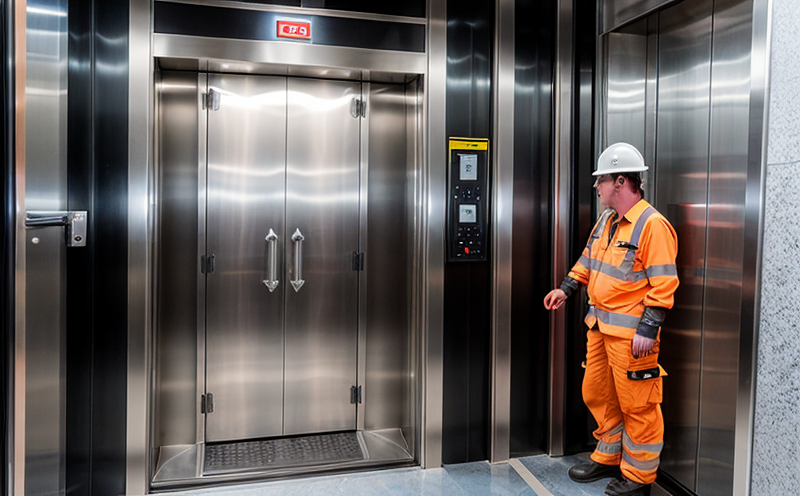Hydraulic elevator inspection
The hydraulic elevator inspection is a critical component of ensuring public safety in buildings that rely on this type of lift system. Hydraulic elevators are particularly prevalent in older commercial and residential structures where the design does not accommodate traditional traction elevators due to limited shaft space or high building height.
These systems operate by using a pump-driven hydraulic cylinder to raise and lower the car, which is why they are crucial for maintaining operational integrity. Regular inspections ensure that these elevators continue to meet safety standards and perform reliably under all conditions. Compliance with international standards such as ISO 13857 and ASME A17.1 is essential in this process.
The inspection involves a comprehensive evaluation of the hydraulic system, including checking for leaks, verifying fluid levels, assessing pump performance, and ensuring that all safety devices are functioning correctly. This includes pressure gauges, safety valves, and other critical components. During an inspection, technicians may also conduct load tests to simulate real-world usage scenarios.
The importance of this service cannot be overstated, especially considering the potential risks associated with failure in a hydraulic elevator system. A malfunction could lead to significant property damage or even injury. By adhering strictly to established protocols and using advanced diagnostic tools, we provide thorough inspections that help prevent such incidents.
A typical inspection process starts by reviewing maintenance logs and identifying any previous issues. Next comes visual inspection of visible components followed by pressure testing under various load conditions. Ultrasonic testing might be employed for detecting internal wear or damage within the cylinder itself. Finally, a functional check ensures all safety interlocks are working properly before issuing certification.
Our team specializes in providing hydraulic elevator inspections tailored to meet specific client needs while adhering strictly to relevant codes and regulations. Whether you need routine maintenance checks or emergency repairs after an incident, our professionals have the expertise required to handle any situation effectively.
Benefits
Regular hydraulic elevator inspections offer numerous benefits for building owners and managers:
- Improved Safety: Ensures compliance with safety regulations, reducing the risk of accidents.
- Extended Equipment Lifespan: Identifies potential issues early on so that repairs can be made before they worsen.
- Cost Savings: Prevents costly downtime by catching problems during routine maintenance instead of waiting for emergencies.
- Enhanced Reputation: Demonstrates a commitment to maintaining high standards, which can positively impact tenant satisfaction and community relations.
- Legal Compliance: Helps avoid fines and penalties associated with non-compliance with local regulations.
- Increased Efficiency: Keeps the elevator running smoothly, minimizing disruptions to daily operations.
In addition to these advantages, our inspections also contribute significantly towards maintaining a safe working environment for maintenance personnel who service these systems. By identifying hazards early, we ensure that they are addressed promptly before becoming more severe issues.
Quality and Reliability Assurance
The quality and reliability assurance processes involved in hydraulic elevator inspections go beyond just checking visible parts of the system; it requires a deep understanding of how each component interacts with others within the overall structure. Our team follows stringent procedures outlined by ASME A17.1, which covers all aspects from initial setup through final certification.
During an inspection, we utilize state-of-the-art equipment to measure critical parameters such as fluid pressure, temperature, and flow rate. These readings are compared against manufacturer specifications to determine if there has been any deviation over time. Additionally, non-destructive testing methods like eddy current or magnetic particle inspection may be used where appropriate.
Once all measurements have been recorded, they are analyzed thoroughly using advanced software tools designed specifically for this purpose. Any discrepancies found will prompt further investigation into their root cause so that corrective actions can be taken promptly. This approach ensures not only immediate resolution but also long-term stability of the elevator system.
We pride ourselves on delivering accurate and reliable results every time, ensuring peace of mind for both clients and end users alike. With years of experience combined with cutting-edge technology, we stand ready to support your organization's needs in providing top-notch service.
Use Cases and Application Examples
Hydraulic elevator inspections are applicable across various sectors including commercial office buildings, hotels, hospitals, multi-family residences, and public transportation facilities. Each of these environments presents unique challenges when it comes to maintaining safe and efficient operation.
In an office building, for instance, the primary concern would be ensuring that the elevator can handle peak loads during business hours without compromising safety standards. This might involve conducting load tests under simulated conditions where heavy carts are used to simulate maximum weight capacity. The results of these tests will inform any necessary adjustments or replacements.
For hotels and resorts, guest comfort takes precedence over all else. Therefore, regular inspections focus heavily on identifying signs of wear and tear that could affect passenger experience negatively if left unaddressed. For example, squeaking doors or rattling shafts are often addressed promptly during routine checks.
In healthcare settings like hospitals, reliability is paramount due to the critical nature of patient mobility within such facilities. Here, inspections emphasize not only structural integrity but also operational efficiency so that patients can move freely between floors without delay.
Multi-family residences present yet another set of challenges owing to their large size and diverse user groups. Ensuring that all elevators are accessible to individuals with disabilities is crucial here. Regular checks ensure compliance with ADA guidelines while also addressing any specific issues unique to these buildings.
Public transportation hubs pose additional complexities due to high traffic volumes and frequent use throughout the day. In these cases, inspections prioritize quick turnaround times so as not to disrupt service schedules unnecessarily. However, this does not mean that thoroughness is compromised; rather, it focuses on efficient procedures that still yield accurate results.
Regardless of the specific application, our goal remains consistent: provide reliable and safe elevators that meet or exceed industry standards at all times.





